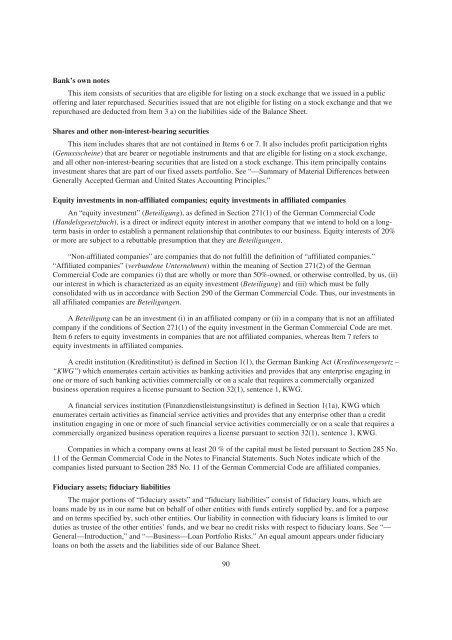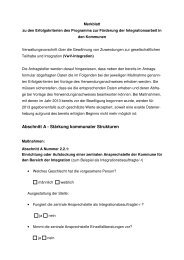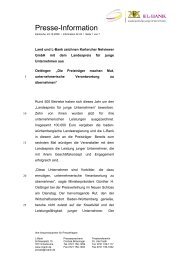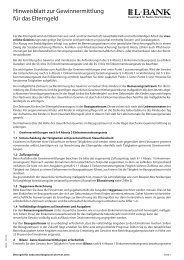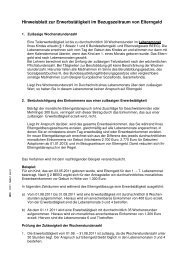Landeskreditbank Baden-Württemberg - L-Bank
Landeskreditbank Baden-Württemberg - L-Bank
Landeskreditbank Baden-Württemberg - L-Bank
Create successful ePaper yourself
Turn your PDF publications into a flip-book with our unique Google optimized e-Paper software.
<strong>Bank</strong>’s own notes<br />
This item consists of securities that are eligible for listing on a stock exchange that we issued in a public<br />
offering and later repurchased. Securities issued that are not eligible for listing on a stock exchange and that we<br />
repurchased are deducted from Item 3 a) on the liabilities side of the Balance Sheet.<br />
Shares and other non-interest-bearing securities<br />
This item includes shares that are not contained in Items 6 or 7. It also includes profit participation rights<br />
(Genussscheine) that are bearer or negotiable instruments and that are eligible for listing on a stock exchange,<br />
and all other non-interest-bearing securities that are listed on a stock exchange. This item principally contains<br />
investment shares that are part of our fixed assets portfolio. See “—Summary of Material Differences between<br />
Generally Accepted German and United States Accounting Principles.”<br />
Equity investments in non-affiliated companies; equity investments in affiliated companies<br />
An “equity investment” (Beteiligung), as defined in Section 271(1) of the German Commercial Code<br />
(Handelsgesetzbuch), is a direct or indirect equity interest in another company that we intend to hold on a longterm<br />
basis in order to establish a permanent relationship that contributes to our business. Equity interests of 20%<br />
or more are subject to a rebuttable presumption that they are Beteiligungen.<br />
“Non-affiliated companies” are companies that do not fulfill the definition of “affiliated companies.”<br />
“Affiliated companies” (verbundene Unternehmen) within the meaning of Section 271(2) of the German<br />
Commercial Code are companies (i) that are wholly or more than 50%-owned, or otherwise controlled, by us, (ii)<br />
our interest in which is characterized as an equity investment (Beteiligung) and (iii) which must be fully<br />
consolidated with us in accordance with Section 290 of the German Commercial Code. Thus, our investments in<br />
all affiliated companies are Beteiligungen.<br />
A Beteiligung can be an investment (i) in an affiliated company or (ii) in a company that is not an affiliated<br />
company if the conditions of Section 271(1) of the equity investment in the German Commercial Code are met.<br />
Item 6 refers to equity investments in companies that are not affiliated companies, whereas Item 7 refers to<br />
equity investments in affiliated companies.<br />
A credit institution (Kreditinstitut) is defined in Section 1(1), the German <strong>Bank</strong>ing Act (Kreditwesengesetz –<br />
“KWG”) which enumerates certain activities as banking activities and provides that any enterprise engaging in<br />
one or more of such banking activities commercially or on a scale that requires a commercially organized<br />
business operation requires a license pursuant to Section 32(1), sentence 1, KWG.<br />
A financial services institution (Finanzdienstleistungsinstitut) is defined in Section 1(1a), KWG which<br />
enumerates certain activities as financial service activities and provides that any enterprise other than a credit<br />
institution engaging in one or more of such financial service activities commercially or on a scale that requires a<br />
commercially organized business operation requires a license pursuant to section 32(1), sentence 1, KWG.<br />
Companies in which a company owns at least 20 % of the capital must be listed pursuant to Section 285 No.<br />
11 of the German Commercial Code in the Notes to Financial Statements. Such Notes indicate which of the<br />
companies listed pursuant to Section 285 No. 11 of the German Commercial Code are affiliated companies.<br />
Fiduciary assets; fiduciary liabilities<br />
The major portions of “fiduciary assets” and “fiduciary liabilities” consist of fiduciary loans, which are<br />
loans made by us in our name but on behalf of other entities with funds entirely supplied by, and for a purpose<br />
and on terms specified by, such other entities. Our liability in connection with fiduciary loans is limited to our<br />
duties as trustee of the other entities’ funds, and we bear no credit risks with respect to fiduciary loans. See “—<br />
General—Introduction,” and “—Business—Loan Portfolio Risks.” An equal amount appears under fiduciary<br />
loans on both the assets and the liabilities side of our Balance Sheet.<br />
90


